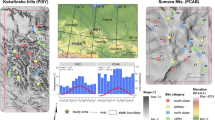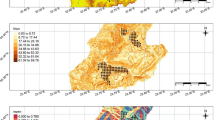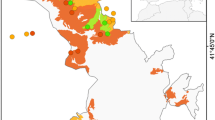Abstract
Calibrating land surface phenology (LSP) with tree rings is important to model spatio-temporal variations in forest productivity. We used MODIS (resolution: 250 m) NDVI, WDRVI and EVI series 2000–2014 to derive LSP metrics quantifying phenophase timing and canopy photosynthetic rates of 26 European beech forests covering a large thermal gradient (5–16 °C) in Italy. Average phenophase timing changed greatly with site temperature (e.g. growing season 70 days longer at low- than high-elevation); average VI values were affected by precipitation. An annual temperature about 12 °C (c. 1100 m asl) represented a bioclimatic threshold dividing warm from cold beech forests, distinguished by different phenology-BAI (basal area increment) relationships and LSP trends. Cold forests showed decreasing VI values (browning) and delayed phenophases and had negative BAI slopes. Warmer forests tended to increase VI (greening), and positive BAI slopes. NDVI peak, commonly used in global trend assessments, changed with elevation in agreement with changes in wood production. A cross-validation modelling approach demonstrated the ability of LSP to predict average BAI and its interannual variability. Merging sites into bioclimatic groups improved models by amplifying the signal in growth or LSP. NDVI had highest performances when informing on BAI trends; WDRVI and EVI were mostly selected for modelling mean and interannual BAI. WDRVI association with tree rings, tested in this study for the first time, showed that this VI is highly promising for studying forest dynamics. MODIS LSP can quantify forest functioning changes across landscapes and model interannual spatial variations and trends in productivity dynamics under climate change.







Similar content being viewed by others
References
Alessandrini A, Vessella F, Di Filippo A et al (2010) Combined dendroecological and normalized difference vegetation index analysis to detect regions of provenance in forest species. Scand J for Res 25:121–125. https://doi.org/10.1080/02827581.2010.485776
Allen DM (1971) The prediction sum of squares as a criterion for selecting predictor variables. Technical Report Number 23. University of Kentucky: Department of Statistics,
Bajocco S, Ferrara C, Alivernini A et al (2019) Remotely-sensed phenology of Italian forests: going beyond the species. Int J Appl Earth Obs Geoinf 74:314–321. https://doi.org/10.1016/j.jag.2018.10.003
Barka I, Bucha T, Molnár T et al (2019) Suitability of MODIS-based NDVI index for forest monitoring and its seasonal applications in Central Europe. Cent Eur for J 66:206–217. https://doi.org/10.2478/forj-2019-0020
Belsley DA, Kuh E, Welsch RE (1980) Regression diagnostics: identifying influential data and sources of collinearity. John Wiley & Sons, New York
Berner LT, Beck PSA, Bunn AG et al (2011) High-latitude tree growth and satellite vegetation indices: correlations and trends in Russia and Canada (1982–2008). J Geophys Res Biogeosciences 116:1–13. https://doi.org/10.1029/2010JG001475
Berra EF, Gaulton R (2021) Remote sensing of temperate and boreal forest phenology: a review of progress, challenges and opportunities in the intercomparison of in-situ and satellite phenological metrics. For Ecol Manage 480:118663. https://doi.org/10.1016/j.foreco.2020.118663
Bhuyan U, Zang C, Vicente-Serrano SM, Menzel A (2017) Exploring relationships among tree-ring growth, climate variability, and seasonal leaf activity on varying timescales and spatial resolutions. Remote Sens 9: https://doi.org/10.3390/rs9060526
Blok D, Sass-Klaassen U, Schaepman-Strub G et al (2011) What are the main climate drivers for shrub growth in Northeastern Siberian tundra? Biogeosciences 8:1169–1179. https://doi.org/10.5194/bg-8-1169-2011
Brehaut L, Danby RK (2018) Inconsistent relationships between annual tree ring-widths and satellite-measured NDVI in a mountainous subarctic environment. Ecol Indic 91:698–711. https://doi.org/10.1016/j.ecolind.2018.04.052
Breiman L, Friedman JH, Olshen RA, Stone CJ (1984) Classification and regression trees. Routledge, New York
Brunetti M, Lentini G, Maugeri M et al (2012) Projecting North Eastern Italy temperature and precipitation secular records onto a high-resolution grid. Phys Chem Earth 40–41:9–22. https://doi.org/10.1016/j.pce.2009.12.005
Brunetti M, Maugeri M, Nanni T et al (2014) High-resolution temperature climatology for Italy: interpolation method intercomparison. Int J Climatol 34:1278–1296. https://doi.org/10.1002/joc.3764
Bucha T, Koren M (2017) Phenology of the beech forests in the western carpathians from MODIS for 2000–2015. Iforest 10:537–546. https://doi.org/10.3832/ifor2062-010
Capdevielle-Vargas R, Estrella N, Menzel A (2015) Multiple-year assessment of phenological plasticity within a beech (Fagus sylvatica L.) stand in southern Germany. Agric for Meteorol 211–212:13–22. https://doi.org/10.1016/j.agrformet.2015.03.019
Caudullo G, Welk E, San-Miguel-Ayanz J (2017) Chorological maps for the main European woody species. Data Br 12:662–666. https://doi.org/10.1016/j.dib.2017.05.007
Chave J, Davies SJ, Phillips OL et al (2019) Ground data are essential for biomass remote sensing missions. Surv Geophys 40:863–880. https://doi.org/10.1007/s10712-019-09528-w
Cook ER, Kairiukstis LA (1990) Methods of dendrochronology: applications in the environmental sciences. Kluwer Academic Publishers, Dordrecht, Netherlands
Coulthard BL, Touchan R, Anchukaitis KJ, et al (2017) Tree growth and vegetation activity at the ecosystem-scale in the eastern Mediterranean. Environ Res Lett 12: https://doi.org/10.1088/1748-9326/aa7b26
Crespi A, Brunetti M, Lentini G, Maugeri M (2018) 1961–1990 high-resolution monthly precipitation climatologies for Italy. Int J Climatol 38:878–895. https://doi.org/10.1002/joc.5217
Čufar K, de Luis M, Saz MA et al (2012) Temporal shifts in leaf phenology of beech (Fagus sylvatica) depend on elevation. Trees - Struct Funct 26:1091–1100. https://doi.org/10.1007/s00468-012-0686-7
Čufar K, De Luis M, Prislan P et al (2015) Do variations in leaf phenology affect radial growth variations in Fagus sylvatica? Int J Biometeorol 59:1127–1132. https://doi.org/10.1007/s00484-014-0896-3
de Beurs KM, Henebry GM (2004) Land surface phenology, climatic variation, and institutional change: analyzing agricultural land cover change in Kazakhstan. Remote Sens Environ 89:497–509. https://doi.org/10.1016/j.rse.2003.11.006
de Beurs KM, Henebry GM (2005) Land surface phenology and temperature variation in the International Geosphere-Biosphere Program high-latitude transects. Glob Chang Biol 11:779–790. https://doi.org/10.1111/j.1365-2486.2005.00949.x
Di Filippo A, Biondi F, Čufar K et al (2007) Bioclimatology of beech (Fagus sylvatica L.) in the Eastern Alps: spatial and altitudinal climatic signals identified through a tree-ring network. J Biogeogr 34:1873–1892. https://doi.org/10.1111/j.1365-2699.2007.01747.x
Di Filippo A, Biondi F, Maugeri M et al (2012) Bioclimate and growth history affect beech lifespan in the Italian Alps and Apennines. Glob Chang Biol 18:960–972. https://doi.org/10.1111/j.1365-2486.2011.02617.x
Dittmar C, Elling W (2006) Phenological phases of common beech (Fagus sylvatica L.) and their dependence on region and altitude in southern germany. Eur J for Res 125:181–188. https://doi.org/10.1007/s10342-005-0099-x
Dye A, Plotkin AB, Bishop D et al (2016) Comparing tree-ring and Permanent plot estimates of aboveground net primary production in three eastern U.S. forests. Ecosphere 7:1–13. https://doi.org/10.1002/ecs2.1454
Di Filippo A, Pederson N, Baliva M, et al (2015) The longevity of broadleaf deciduous trees in Northern Hemisphere temperate forests: insights from tree-ring series. Front Ecol Evol 3: https://doi.org/10.3389/fevo.2015.00046
Di Filippo A, Baliva M, Brunetti M, Di Fiore L (2021) Long-term tree-ring response to drought and frost in two pinus halepensis populations growing under contrasting environmental conditions in Peninsular Italy. Forests 12:
Forbes BC, Fauria MM, Zetterberg P (2010) Russian Arctic warming and “greening” are closely tracked by tundra shrub willows. Glob Chang Biol 16:1542–1554. https://doi.org/10.1111/j.1365-2486.2009.02047.x
Forkel M, Wutzler T (2015) Greenbrown - land surface phenology and trend analysis. A package for the R software. Version 2.2, 2015–04–15, http://greenbrown.r-forge.r-project.org/ Accessed 15 December 2021
Fu YH, Piao S, Op de Beeck M et al (2014) Recent spring phenology shifts in western Central Europe based on multiscale observations. Glob Ecol Biogeogr 23:1255–1263. https://doi.org/10.1111/geb.12210
Fu YH, Zhao H, Piao S et al (2015) Declining global warming effects on the phenology of spring leaf unfolding. Nature 526:104–107. https://doi.org/10.1038/nature15402
Girardin MP, Bouriaud O, Hogg EH et al (2016) No growth stimulation of Canada’s boreal forest under half-century of combined warming and CO2 fertilization. Proc Natl Acad Sci U S A 113:E8406–E8414. https://doi.org/10.1073/pnas.1610156113
Hamed KH, RamachandraRao A (1998) A modified Mann-Kendall trend test for autocorrelated data. J Hydrol 204:182–196. https://doi.org/10.1016/S0022-1694(97)00125-X
Hmimina G, Dufrêne E, Pontailler JY et al (2013) Evaluation of the potential of MODIS satellite data to predict vegetation phenology in different biomes: an investigation using ground-based NDVI measurements. Remote Sens Environ 132:145–158. https://doi.org/10.1016/j.rse.2013.01.010
Horn JL (1965) A rationale and test for the number of factors in factor analysis. Psychometrika 30:179–185
Huang K, Xia J, Wang Y et al (2018) Enhanced peak growth of global vegetation and its key mechanisms. Nat Ecol Evol 2:1897–1905. https://doi.org/10.1038/s41559-018-0714-0
Huete A, Didan K, Miura T et al (2002) Overview of the radiometric and biophysical performance of the MODIS vegetation indices. Remote Sens Environ 83:195–213. https://doi.org/10.1016/S0034-4257(02)00096-2
Hufkens K, Friedl MA, Keenan TF et al (2012) Ecological impacts of a widespread frost event following early spring leaf-out. Glob Chang Biol 18:2365–2377. https://doi.org/10.1111/j.1365-2486.2012.02712.x
IPCC (2022) Climate Change 2022: impacts, adaptation and vulnerability. Contribution of Working Group II to the Sixth Assessment Report of the Intergovernmental Panel on Climate Change [H.-O. Pörtner, D.C. Roberts, M. Tignor, E.S. Poloczanska, K. Mintenbeck, A. Alegría, M. Craig, S. Langsdorf, S. Löschke, V. Möller, A. Okem, B. Rama (eds.)]. Cambridge University Press. Cambridge University Press, Cambridge, UK and New York, NY, USA, 3056 pp., https://doi.org/10.1017/9781009325844.
Jin H, Jönsson AM, Olsson C et al (2019) New satellite-based estimates show significant trends in spring phenology and complex sensitivities to temperature and precipitation at northern European latitudes. Int J Biometeorol 63:763–775. https://doi.org/10.1007/s00484-019-01690-5
Kaufmann RK, D’Arrigo RD, Paletta LF et al (2008) Identifying climatic controls on ring width: the timing of correlations between tree rings and NDVI. Earth Interact 12:1–14. https://doi.org/10.1175/2008EI263.1
Kozlowski TT (1992) Carbohydrate sources and sinks in woody plants. Bot Rev 58:107–222. https://doi.org/10.1007/BF02858600
Kutner MH, Nachtsheim C, Neter J (2004) Applied linear regression models. McGraw-Hill/Irwin, New York
Liang L, Schwartz MD, Fei S (2011) Validating satellite phenology through intensive ground observation and landscape scaling in a mixed seasonal forest. Remote Sens Environ 115:143–157. https://doi.org/10.1016/j.rse.2010.08.013
Liu Q, Piao S, Janssens IA, et al (2018) Extension of the growing season increases vegetation exposure to frost. Nat Commun 9: https://doi.org/10.1038/s41467-017-02690-y
Lopatin E, Kolström T, Spiecker H (2006) Determination of forest growth trends in Komi Republic (northwestern Russia): combination of tree-ring analysis and remote sensing data. Boreal Environ Res 11:341–353
Lukasová V, Bucha T, Škvareninová J, Škvarenina J (2019) Validation and application of European beech phenological metrics derived from MODIS data along an altitudinal gradient. Forests 10: https://doi.org/10.3390/f10010060
Macias-Fauria M, Forbes BC, Zetterberg P, Kumpula T (2012) Eurasian Arctic greening reveals teleconnections and the potential for structurally novel ecosystems. Nat Clim Chang 2:613–618. https://doi.org/10.1038/nclimate1558
Menzel A, Sparks TH, Estrella N et al (2006) European phenological response to climate change matches the warming pattern. Glob Chang Biol 12:1969–1976. https://doi.org/10.1111/j.1365-2486.2006.01193.x
Misra G, Buras A, Heurich M et al (2018) LiDAR derived topography and forest stand characteristics largely explain the spatial variability observed in MODIS land surface phenology. Remote Sens Environ 218:231–244. https://doi.org/10.1016/j.rse.2018.09.027
Pan N, Feng X, Fu B et al (2018) Increasing global vegetation browning hidden in overall vegetation greening: insights from time-varying trends. Remote Sens Environ 214:59–72. https://doi.org/10.1016/j.rse.2018.05.018
Parajka J, Blöschl G (2006) Validation of MODIS snow cover images over Austria. Hydrol Earth Syst Sci 10:679–689. https://doi.org/10.5194/hess-10-679-2006
Peng D, Wu C, Li C et al (2017) Spring green-up phenology products derived from MODIS NDVI and EVI: intercomparison, interpretation and validation using National Phenology Network and AmeriFlux observations. Ecol Indic 77:323–336. https://doi.org/10.1016/j.ecolind.2017.02.024
Piao S, Wang X, Park T, et al (2020) Characteristics, drivers and feedbacks of global greening. Nat Rev Earth Environ 1: https://doi.org/10.1038/s43017-019-0001-x
Piovesan G, Biondi F, Bernabei M et al (2005) Spatial and altitudinal bioclimatic zones of the Italian peninsula identified from a beech (Fagus sylvatica L.) tree-ring network. Acta Oecologica 27:197–210. https://doi.org/10.1016/j.actao.2005.01.001
Piovesan G, Biondi F, Di Filippo A et al (2008) Drought-driven growth reduction in old beech (Fagus sylvatica L.) forests of the central Apennines. Italy Glob Chang Biol 14:1265–1281. https://doi.org/10.1111/j.1365-2486.2008.01570.x
Proietti R, Antonucci S, Monteverdi MC et al (2020) Monitoring spring phenology in Mediterranean beech populations through in situ observation and Synthetic Aperture Radar methods. Remote Sens Environ 248:111978. https://doi.org/10.1016/j.rse.2020.111978
Richardson AD, Hufkens K, Milliman T, Frolking S (2018) Intercomparison of phenological transition dates derived from the PhenoCam Dataset V1.0 and MODIS satellite remote sensing. Sci Rep 8:1–12. https://doi.org/10.1038/s41598-018-23804-6
Rouse JW, Hass RH, Schell JA, Deering DW (1973) Monitoring vegetation systems in the great plains with ERTS. Third Earth Resour Technol Satell Symp 1:309–317
Sangüesa-barreda G, Di Filippo A, Piovesan G et al (2021) Warmer springs have increased the frequency and extension of late-frost defoliations in southern European beech forests. Sci Total Environ 775:145860. https://doi.org/10.1016/j.scitotenv.2021.145860
Schär C, Jendritzky G (2004) Hot news from summer 2003. Nature 432:559–560. https://doi.org/10.1038/432559a
Sen PK (1968) Estimates of the regression coefficient based on Kendall’s tau. J Am Stat Assoc 63:1379–1389. https://doi.org/10.1080/01621459.1968.10480934
Testa S, Soudani K, Boschetti L, Borgogno Mondino E (2018) MODIS-derived EVI, NDVI and WDRVI time series to estimate phenological metrics in French deciduous forests. Int J Appl Earth Obs Geoinf 64:132–144. https://doi.org/10.1016/j.jag.2017.08.006
Viña A, Henebry GM, Gitelson AA (2004) Satellite monitoring of vegetation dynamics: sensitivity enhancement by the wide dynamic range vegetation index. Geophys Res Lett 31:1–4. https://doi.org/10.1029/2003GL019034
Vitasse Y, Basler D (2013) What role for photoperiod in the bud burst phenology of European beech. Eur J for Res 132:1–8. https://doi.org/10.1007/s10342-012-0661-2
Vitasse Y, Porté AJ, Kremer A et al (2009) Responses of canopy duration to temperature changes in four temperate tree species: relative contributions of spring and autumn leaf phenology. Oecologia 161:187–198. https://doi.org/10.1007/s00442-009-1363-4
Vitasse Y, Bresson CC, Kremer A et al (2010) Quantifying phenological plasticity to temperature in two temperate tree species. Funct Ecol 24:1211–1218. https://doi.org/10.1111/j.1365-2435.2010.01748.x
Vitasse Y, Ursenbacher S, Klein G et al (2021) Phenological and elevational shifts of plants, animals and fungi under climate change in the European Alps. Biol Rev 96:1816–1835. https://doi.org/10.1111/brv.12727
Wang S, Yang B, Yang Q et al (2016) Temporal trends and spatial variability of vegetation phenology over the Northern Hemisphere during 1982–2012. PLoS ONE 11:1–21. https://doi.org/10.1371/journal.pone.0157134
Wang X, Xiao J, Li X et al (2019) No trends in spring and autumn phenology during the global warming hiatus. Nat Commun 10:1–10. https://doi.org/10.1038/s41467-019-10235-8
White MA, Thornton PE, Running SW (1997) A continental phenology model for monitoring vegetation responses to interannual climatic variability. Global Biogeochem Cycles 11:217–234. https://doi.org/10.1029/97GB00330
Wingate L, Ogeé J, Cremonese E et al (2015) Interpreting canopy development and physiology using a European phenology camera network at flux sites. Biogeosciences 12:5995–6015. https://doi.org/10.5194/bg-12-5995-2015
Wong CYS, Young DJN, Latimer AM et al (2021) Importance of the legacy effect for assessing spatiotemporal correspondence between interannual tree-ring width and remote sensing products in the Sierra Nevada. Remote Sens Environ 265:112635. https://doi.org/10.1016/j.rse.2021.112635
Xue J, Su B (2017) Significant remote sensing vegetation indices: a review of developments and applications. J Sensors 2017: https://doi.org/10.1155/2017/1353691
Zhang X, Friedl MA, Schaaf CB (2009) Sensitivity of vegetation phenology detection to the temporal resolution of satellite data. Int J Remote Sens 30:2061–2074. https://doi.org/10.1080/01431160802549237
Zhang Y, Song C, Band LE et al (2017) Reanalysis of global terrestrial vegetation trends from MODIS products: browning or greening? Remote Sens Environ 191:145–155. https://doi.org/10.1016/j.rse.2016.12.018
Zhu Z, Piao S, Myneni RB et al (2016) Greening of the Earth and its drivers. Nat Clim Chang 6:791–795. https://doi.org/10.1038/nclimate3004
Acknowledgements
We thank two anonymous reviewers for constructive comments on previous versions of the manuscript. We thank Tobias Gränzig for advice. Research partially supported by the Ministry of Instruction, University and Research (MIUR) “Department of excellence” (Law 232/2016) and FISR-MIUR project “Italian Mountain Lab”.
Author information
Authors and Affiliations
Corresponding author
Supplementary Information
Below is the link to the electronic supplementary material.
Rights and permissions
Springer Nature or its licensor holds exclusive rights to this article under a publishing agreement with the author(s) or other rightsholder(s); author self-archiving of the accepted manuscript version of this article is solely governed by the terms of such publishing agreement and applicable law.
About this article
Cite this article
Di Fiore, L., Brunetti, M., Baliva, M. et al. Modelling Fagus sylvatica stem growth along a wide thermal gradient in Italy by incorporating dendroclimatic classification and land surface phenology metrics. Int J Biometeorol 66, 2433–2448 (2022). https://doi.org/10.1007/s00484-022-02367-2
Received:
Revised:
Accepted:
Published:
Issue Date:
DOI: https://doi.org/10.1007/s00484-022-02367-2




